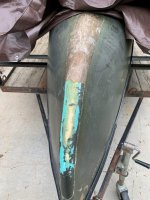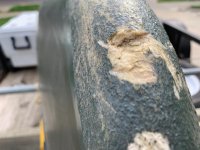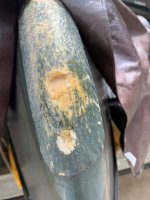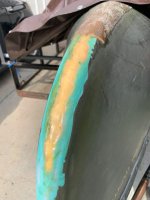1. Is there a general guide as to how much resin to mix up (in my case g/flex 650 - the 2 4oz bottle kit) based on the amount of material you're using? I believe i was told by West Systems this kit i have is good for 2 "normal" skid plates. I'm kinda applying a half skid plate in this scenario. Just don't want to waste or not have enough.
My “16oz tubes” was based on removing the half gone one and laying new felt, and maybe topcoating the other skid plate after the pothole had been patched.
I guess 8 oz should do it, although I wonder if West System understood this was for kevlar felt, which is a very thirsty material. Plus I take it you already have both the 655 and 650.
It will help lessen the viscosity if the epoxy is warm, or at least not cold, and it will brush on/through the fabric easier. I tape the perimeter, lay a (thick) coat of epoxy in the box, lay the fabric and then topfill with epoxy.
2. To achieve a more tapered edge is it okay to just sand the edges once the skid plate has dried? I'm a little concerned about the transition where the old skid plate will be under the new and the amount of tall edge that i'm assuming will be there when it's all said and done. Maybe i should have rather taken a Dremel and cut a straight edge on the old skid plate and put the new one butt up against it?
I would not lap the new felt over the old, but instead lay a precut piece of felt a couple inches overlong in place dry fit, use a sharpie to trace out the jagged break and cut that end to match. Kevlar felt is quite stretchy, and you should be able to drag the wet felt into puzzle place. If there is a crevice at the break after the wax paper comes off infill it with thickened epoxy
Especially if that is the stern skid plate, where the overlapped edge would be facing forward and more likely to catch a rock.
On the new felt if you tongue depressor ¼” along the sides with the wax paper in place you shouldn’t need to do much else to those edges.
Sanding the tall, existing edge on the old skid plate will tricky. The existing felt/epoxy itself is tough, and it’s hard to avoid sanding into the hull past the edge. I carefully RO 60 grit sanded as near the edges as I dared on the Appalachian, but needed to use a file to knock down some really tall edges and urethane drips.
The bead of thicken G/flex did a decent job of beveling out that transition edge.
Time to mix some epoxy myself.
EDIT: Before I forget, it will be easier to properly align the kevlar felt inside the tape box if you draw a centerline up the new piece of material.
Edit to the edit: I finished topcoating the two existing skid plates on the Appalachian using straight G/flex with graphite powder. Admittedly laid on near 10% by volume thickened with graphite powder, but I estimate I used 2oz of G/flex just to topcoat those non-thirsty existing skid plates.
The good part is that the graphite powder thickened top coat isn’t dripping down the tape and mask nearly as badly as regular epoxy, or even a 50/50 mix of West 105/206 and G/flex
Edit to the Edit X3: Keep compressing the edge of the felt under the wax paper as the epoxy sets up to achieve an firm, held compressed angled/beveled edge. Walk back with tongue depressor in hand every half hour until the epoxy firms up. Don’t even need gloves, and it only takes a few well-worth it seconds.
Edit to the ad nauseum. If you plan to top coat it with anything, varnish, paint, even another coat of epoxy, scrub the bejesus out of it first.
Nothing sticks to wax paper residue.




